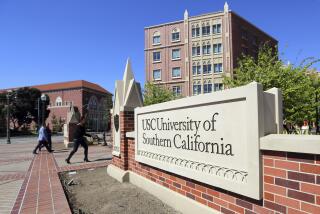One in four female undergraduates reports sexual misconduct, survey finds
- Share via
More than 1 in 4 female undergraduate students say they have been victimized by nonconsensual sexual contact, according to a survey released Monday of 27 universities across the country.
But the survey for the Assn. of American Universities, one of the most comprehensive ever conducted on college sexual misconduct, found wide variation in the cases depending on campus, gender, age and type of offense.
In California, for instance, 29.7% of female undergraduates at USC and 12.7% at Caltech reported the most serious sexual misconduct — sexual penetration or touching involving force or incapacitation by alcohol or drugs.
Nationally, the rate of such misconduct ranged from 13% to 30% across campuses. The risk was highest for freshmen women, whose rate was 16.9%, compared with 11.1% for seniors in 2014-15. Over the course of their college life, 27.2% of senior females reported being victimized.
The online survey of 150,000 students also found low rates of reporting sexual misconduct and a mixed response over whether respondents believed their university would conduct a fair investigation. But the vast majority of those who actually reported their cases gave high marks to officials for showing them respect and helping them understand their options.
“The purpose of this survey is to enhance the safety of students on our campuses,” Hunter Rawlings, the association’s president, said in a teleconference Monday.
Many universities have moved to improve their response to campus sexual misconduct since the federal government began cracking down in 2011 with a record number of policy directives, fines and more than 100 investigations. Rawlings said the survey data can also be used to assist policymakers in crafting additional responses.
Participants in the survey, conducted by research firm Westat, also included students at Harvard, Yale, Brown, Cornell, Columbia and Purdue universities; Dartmouth College and the University of Arizona.
The survey asked students whether the nonconsensual sexual contact occurred by force, incapacitation, nonphysical coercion or the absence of “affirmative consent,” an emerging standard that requires both partners to explicitly agree to the encounter. Physical force was the most prevalent tactic and coercion the least.
Overall, 28% of female undergraduates reported they were victimized by any of the four tactics. About 23% of female undergraduates and 11.7% of all students surveyed reported the most serious — physical force and incapacitation — had been used against them.
One possible flaw in the survey is that its response rate of 19.3% was relatively low, which could result in a slight upward bias. Victims could be more likely to respond to the survey than non-victims.
For example, students at USC had a response rate of 19.4% and the results showed a higher rate of reported sexual misconduct than at Caltech, where 47.1% of students responded to the survey.
Female undergraduates at USC voiced less confidence in university procedures to handle complaints than did males on campus and female grad students.
“Our conviction is that one sexual assault in our community is one too many,” said a letter issued Monday to the campus community by Provost Michael Quick and Ainsley Carry, vice president for student affairs.
The survey also found:
Rates of assault were highest among students who identified as transgender, genderqueer (a term the survey uses but does not define), nonconforming, questioning or a category not listed on the survey.
Rates of reporting ranged from 5% to 28%, depending on the type of violation involved. More than half of those surveyed said they did not report it because they didn’t think it was serious enough, while others said they were too embarrassed or ashamed, among other reasons.
Six out of 10 female undergraduates said they had been sexually harassed, a category separate from sexual contact. Gays and lesbians reported harassment rates of 60.4%, compared with 45.9% of heterosexuals.
Most students did nothing while witnessing a drunk person headed for what they thought would be a sexual encounter or cases of sexual violence or harassment.
Twitter: @TeresaWatanabe
ALSO:
Rural radio station offers a calming voice amid Valley fire confusion
The heat and the lines couldn’t keep them from the Broad on opening day
Gentrification foes worry that Eastside housing group is displacing Boyle Heights residents
More to Read
Sign up for Essential California
The most important California stories and recommendations in your inbox every morning.
You may occasionally receive promotional content from the Los Angeles Times.














